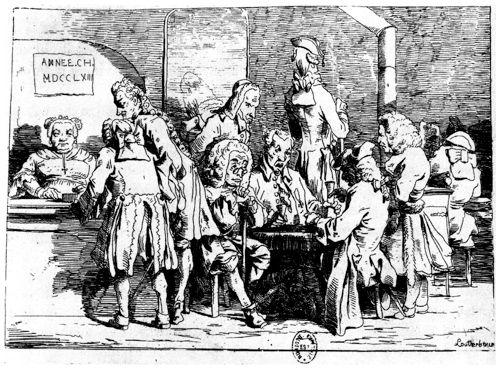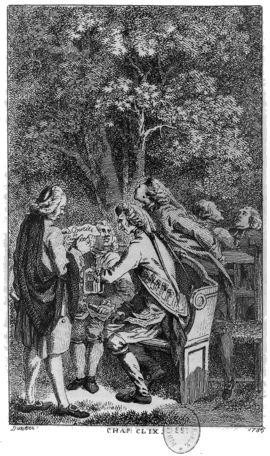
Blogging brings out the hit-and-run element in communication. Bloggers tend to be punchy. They often hit below the belt; and when they land a blow, they dash off to another target. Pow! The idea is to provoke, to score points, to vent opinions, and frequently to gossip.
The most gossipy blogs take aim at public figures, combining two basic ingredients, scurrility and celebrity, and they deal in short jabs, usually nothing longer than a paragraph. They often appeal to particular constituencies such as Hollywood buffs (Perez Hilton), political junkies (Wonkette), college kids (IvyGate), and lawyers (Underneath Their Robes). Politically they may lean to the right (Michelle Malkin) or to the left (Daily Kos). But all of them conform to a formula derived from old-fashioned tabloid journalism: names make news.
How new, then, is bloggery? Should we think of it as a by-product of the modern means of communication and a sign of a time when newspapers seem doomed to obsolescence? It makes the most of technical innovations—the possibility of constant contact with virtual communities by means of web sites and the premium placed on brevity by platforms such as Twitter with its limit of 140 characters per message. Yet blog-like messaging can be found in many times and places long before the Internet.
Here, for example, is a recent post on The Superficial:
RadarOnline reports “traditional marriage” crusader and former Miss California Carrie Prejean is living in sin with her fiancé Kyle Boller of the St. Louis Rams where they’re no doubt eating shellfish. BURN THEM!
And here is a typical entry from Le Gazetier cuirassé ou anecdotes scandaleuses de la cour de France (1771):
Mlle. Romans is soon to marry M. de Croismare, Governor of the Ecole Militaire, who will use six aides de camp to take his place in performing the conjugal service.
Short, scurrilous abuse proliferated in all sorts of communication systems: taunts scribbled on palazzi during the feuds of Renaissance Italy, ritual insult known as “playing the dozens” among African Americans, posters carried in demonstrations against despotic regimes, and graffiti on many occasions such as the uprising in Paris of May–June 1968 (one read “Voici la maison d’un affreux petit bourgeois”). When expertly mixed, provocation and pithiness could be dynamite—the verbal or written equivalent of Molotov cocktails.
This subject deserves more study, because for all of their explosiveness, the blog-like elements in earlier eras of communication tend to be ignored by sociologists, political scientists, and historians who concentrate on full-scale texts and formal discourse.
To appreciate the importance of a pre-modern blog, consult a database such as Eighteenth Century Collections Online and download a newspaper from eighteenth-century London. It will have no headlines, no bylines, no clear distinction between news and ads, and no spatial articulation in the dense columns of type, aside from one crucial ingredient: the paragraph. Paragraphs were self-sufficient units of news. They had no connection with one another, because writers and readers had no concept of a news “story” as a narrative that would run for more than a few dozen words. News came in bite-sized bits, often “advices” of a sober nature—the arrival of a ship, the birth of an heir to a noble title—until the 1770s, when they became juicy. Pre-modern scandal sheets appeared, exploiting the recent discovery about the magnetic pull of news toward names. As editors of the Morning Post and the Morning Herald, two men of the cloth, the Reverend Henry Bate (known as “the Reverend Bruiser”) and the Reverend William Jackson (known as “Dr. Viper”) packed their paragraphs with gossip about the great, and this new kind of news sold like hotcakes. Much of it came from a bountiful source: the coffee house.
London coffee houses were nerve centers, where regulars picked up talk about the private lives of public figures. Some regulars reduced the talk to writing, always in the form of a paragraph, and turned their bulletins in to editors or editor-compositors who set them in type and aligned the typeset paragraphs in columns on the imposing stone, ready for printing as the “freshest advices.” Known as “paragraph men,” these early-modern reporters might get paid by the piece or they might supply copy in order to score points in the daily struggle to master public opinion. Some did it for their own pleasure—like many bloggers today.
The French café functioned in the same manner, but the French press was censored, and French-language journals printed outside France took great care to avoid offending French authorities. Gossipy news therefore circulated “under the cloak” in the form of short notes scribbled on scraps of paper that were carried around in pockets and passed from hand to hand. (Some of them still exist in the archives of the Bastille, because they were confiscated when the police frisked prisoners.) Although these bulletins usually contained only a few sentences, they were not called paragraphs. They were known as “anecdotes.”
Advertisement

Two to three hundred years ago, the term anecdote meant nearly the opposite of what it means today. Instead of representing a trivial incident or unreliable hearsay, as in the expression “anecdotal evidence,” it conveyed the notion of “secret history”—episodes concerning the private lives of important personages that had actually taken place but could not be published openly. According to contemporary dictionaries and Diderot’s Encyclopédie, the concept derived from Procopius, the Byzantine historian of the sixth century B.C.E., who wrote scandalous secret histories about the private lives of Justinian, Theodora, and Belisarius to accompany the politically correct narratives of his formal histories.
Procopius—no connection with the famous Parisian Café Procope—was recognized as the remote ancestor of another variety of early-modern blogger, the “nouvelliste.” Gossip mongers who worked oral circuits of communication were known as “nouvellistes de bouche.” When they reduced news to written anecdotes and strung the anecdotes together in manuscript “gazetins”, they graduated into the ranks of “nouvellistes à la main.” Here are some examples collected by the pamphleteer Pierre Manuel:
The prince de Conti was knocked out of commission by a girl known as the Little F…..He blames it on Guerin, his medical advisor.
The duc de … surprised his wife in the arms of his son’s tutor. She said to him with an impudence worthy of a courtier, “Why weren’t you there, Monsieur? When I don’t have my esquire, I take the arm of my lackey.”
These illegal newssheets proliferated everywhere in eighteenth-century France, owing to the demand for news, especially news of the saltiest variety. The police tried to repress them, but for every “nouvelliste” locked up in the Bastille, a half-dozen more took up the pen. Eventually, the police sought to gain control of this underground press by compiling their own manuscript gazettes—which eventually lost credence and were supplanted by still more “nouvelles à la main.”
Whether exchanged orally in a café, scribbled on a scrap of paper, or combined as paragraphs in a newssheet, anecdotes operated as the primary unit in a system of communication. Many of them found their way into print. They were picked up by famous writers like Voltaire, but more often they appeared in anonymous tracts known as “libelles.” The spiciest “libelles” —works such as Anecdotes sur Mme la comtesse du Barry and Vie privée de Louis XV—became bestsellers. If you read them carefully, you find that they contain a great many passages that were lifted from one another or from common underground gazettes. They were really collages pieced together from pre-existing material and whatever new items that were available—just like today’s blogs, which serve up compilations of tidbits collected from around the web. Instead of imagining this literature as a corpus of books written by distinct authors, you should think of it as a shifting repertory of anecdotes, which were endlessly rearranged as they passed from one form to another.
The anecdotes constituted the early-modern equivalent of a blogosphere, one laced with explosives; for on the eve of the Revolution, French readers were consuming as much smut about the private lives of the great as they were reading treatises about the abuse of power. In fact, the anecdotes and the political discourse reinforced each other. I would therefore argue that the early-modern blog played an important part in the collapse of the Old Regime and in the politics of the French Revolution. I must admit, however, that I am consigning this argument to a blog. Anyone who wants to see it developed at an appropriate length and with supporting evidence will have to read it as a book: The Devil in the Holy Water, or the Art of Slander from Louis XIV to Napoleon.
I don’t believe that history teaches lessons, at least not in a direct, easily applied manner, but it does raise questions. Are blogs disrupting traditional politics today just as “libelles” did in eighteenth-century France?


